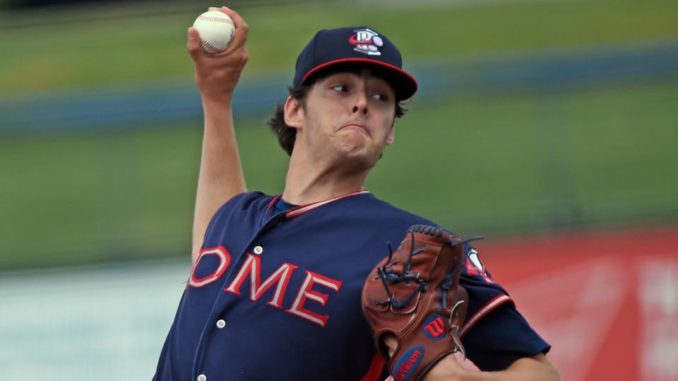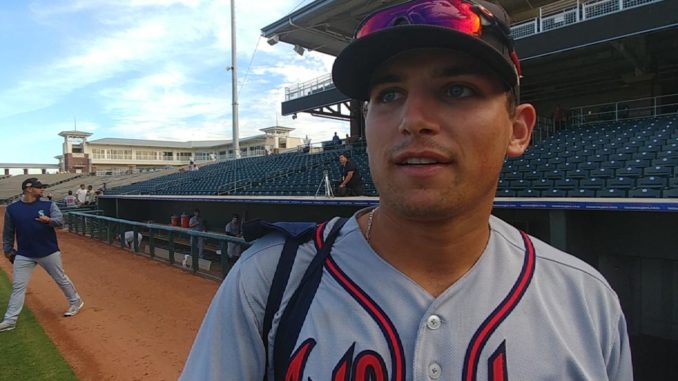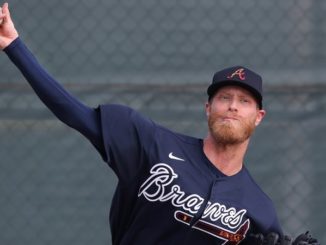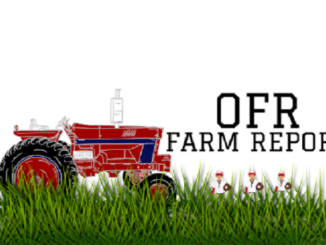
7. Ian Anderson, RHP
Age: 19 | Throws: R
3.14 ERA | 3.04 FIP | 20 G, 20 GS | 83.0 IP | 4.66 BB/9 | 10.95 K/9
Current Assignment: Class A Rome
Acquired: Drafted, 1st Round – 2016
Midseason 2017 OFR Ranking: 9
Superlatives: Baseball America #6 Prospect in the South Atlantic League
History: Anderson overcame pneumonia in his senior year of high school to become a the Braves first round draft pick in 2016, the 3rd pick overall. Anderson’s pro career got off to a good start in 2016, pitching to a 2.04 ERA/2.93 FIP over two rookie league levels, though the Braves were very cautious with his innings, keeping them just under 40 for the season. That cautiousness continued in 2017 at Rome, as Anderson was limited to 17.2 innings after July 1. Nevertheless, Anderson showed flashes of dominance and held opponents to a .232/.348/.268 batting line against. Anderson only allowed 10 extra base hits against him and no home runs.
Pitching: Anderson is a listed at 6’-3”, 170 pounds but looks to have filled out a little since those measurements. Anderson has a mid-90’s fastball that can top out at around 97 with strong glove-side movement. Anderson works up and down the strikezone well. Anderson complements the fastball with a nasty, sharp-breaking curveball and a change-up that shows up at around half of his outings, but when it’s there can be a dominating pitch. Anderson can sometimes lose his release point, which can interfere with his control. SAL umpires also tended to be an issue with Anderson, as his fastball had enough movement that umpires occasionally gave up on it. Anderson is fairly unflappable on the mound, always giving an air of control even when he’s not getting the breaks.
What’s Next: The results weren’t there for him all the time, but Anderson had a strong second season in professional ball. He should move up to high-A Florida, and hopefully the Braves will allow Anderson to pitch more significant innings longer into the season.

6. Austin Riley, 3B
Age: 21 | Bats: R
.275/.339/.446 | 129 wRC+ | 20 HR | 2 SB | 7.9% BB | 22.9% K
Current Assignment: Class AA Mississippi
Acquired: Drafted, 1st Round – 2015 (pick acquired from Padres)
Midseason 2017 OFR Ranking: 11
Superlatives: OFR Florida Fire Frog Position Player of the Year, Florida State League All-Star, Arizona Fall League All-Star, Baseball America’s #6 Prospect of the Southern League
History: A compensation round pick in 2015, Riley was scouted heavily as a pitcher by most teams but the Braves wanted him as a hitter and installed him at third base in the rookie leagues. Riley responded with 12 home runs and a .304/.389/.544 batting line in 60 games split between the GCL and Danville. For 2016, Riley was assigned to and spent the whole season in Rome, where he struggled in the first months of the season. Riley dramatically improved his production in the second half of the season. Riley hit 15 of his 22 home runs after July 1 and hit .282/.347/.568 clip to help propel Rome to a South Atlantic League championship.
Riley was assigned to high-A Florida to start 2017, and once again had a slow start to the season at the plate, though not as slow as in Rome and it didn’t last as long in the pitcher-friendly league. Riley’s power stayed consistent, and he had 12 homers through mid-July. Riley had a six-game hitting streak starting July 4 and that seemed to be the sign the Braves were looking for to promote him to AA Mississippi. Riley scuffled the rest of July but took off when the calendar flipped to August, hitting .373/.450/.636 the rest of the way. His hot hitting carried over into the Arizona Fall League, where he hit .300/.364/.657 with 6 homers in 17 games, just one home run behind league leader and teammate Ronald Acuna.
Offense: Riley is extremely strong, with more raw power than anyone in the Braves farm system save perhaps Alex Jackson. Riley has made significant strides in the areas of pitch recognition and situational hitting. Last season Riley was looking to pull the ball over the fence with every swing, but he has learned to stay back on the ball and bloop the ball the opposite way with a runner on second for the easy RBI, to take one situation. Much has been made in some quarters about Riley’s bat speed, which is a little below average. Riley combats this issue by having very strong hands and wrists that give him good bat control, as well as the improved plate discipline.
Defense: Even more impressive than his strides with the bat has been his work in the field. After last season, I would have placed the odds of his staying at third base at less than 50% given his poor range and iffy hands. To his credit, Riley has clearly put in the work to bring himself up to at least an average defensive third baseman. His instincts to the ball are much better, which help his still below-average lateral range. His hands have gotten better as well. He still has the canon arm from his pitching days, but this season saw him cut his throwing errors from the year before by two-thirds. The overall package of improvement make him near certain to be able to stick at third.
What’s Next: Riley should get his first major league spring training invitation, and then it’s up to him. Riley may go back to AA Mississippi to start the season, but based on his AFL performance and a strong spring, the organization may elect to send him on to AAA Gwinnett. Either way, continued improvement could have him in Atlanta by late 2018, though a 2019 debut is probably more likely. In any case, Riley represents the chance that the Braves will finally be able to get off the third base merry-go-round they’ve been on since the retirement of Chipper Jones.




Leave a Reply